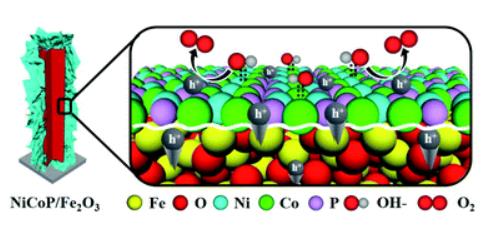Abstract
The sluggish surface oxygen evolution reaction (OER) kinetics at the photoanode/electrolyte interface severely restrict the photoelectrochemical (PEC) performances for water splitting. Herein, we demonstrated the construction of large-size and ultrathin NiCoP nanosheets on hierarchical Fe2O3 nanorod photoanodes for significantly promoting the PEC water oxidation activity. Specifically, the obtained NiCoP/Fe2O3 photoanodes exhibited an excellent photocurrent density of 3.8 mA cm(-2) at 1.23 V versus the reversible hydrogen electrode (RHE). Comprehensive investigations reveal that the tight interfacial interaction could effectively facilitate the rapid transfer of photogenerated holes from Fe2O3 to NiCoP, and the abundant surface active sites on large-size and ultrathin NiCoP cocatalysts dramatically enhance the OER kinetics. These findings may offer a new insight into rational regulation of the photoanode/cocatalyst interface for highly efficient PEC water splitting.

Keywords Plus:HIGHLY EFFICIENTHEMATITENANOSTRUCTUREPERFORMANCEARRAYSLAYER
Published in JOURNAL OF MATERIALS CHEMISTRY A,Volume10;10.1039/d2ta02702j,JUN 21 2022


